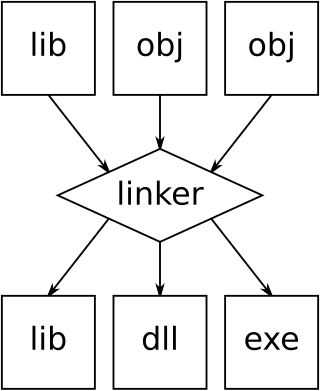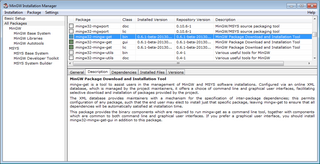
A linker or link editor is a computer program that combines intermediate software build files such as object and library files into a single executable file such a program or library. A linker is often part of a toolchain that includes a compiler and/or assembler that generates intermediate files that the linker processes. The linker may be integrated with other toolchain tools such that the user does not interact with the linker directly.
DLL hell is an umbrella term for the complications that arise when one works with dynamic-link libraries (DLLs) used with older Microsoft Windows operating systems, particularly legacy 16-bit editions, which all run in a single memory space. DLL hell can appear in many different ways, wherein affected programs may fail to run correctly, if at all. It is the Windows ecosystem-specific form of the general concept dependency hell.
A shared library is a library that contains executable code designed to be used by multiple computer programs or other libraries at runtime, with only one copy of that code in memory, shared by all programs using the code.
The Portable Executable (PE) format is a file format for executables, object code, dynamic-link-libraries (DLLs), and binary files used on 32-bit and 64-bit Windows operating systems, as well as in UEFI environments. It is the standard format for executables on Windows NT-based systems, including files such as .exe, .dll, .sys, and .mui. At its core, the PE format is a structured data container that gives the Windows operating system loader everything it needs to properly manage the executable code it contains. This includes references for dynamically linked libraries, tables for importing and exporting APIs, resource management data and thread-local storage (TLS) information.

In computing, a library is a collection of resources that is leveraged during software development to implement a computer program. Commonly, a library consists of executable code such as compiled functions and classes, or a library can be a collection of source code. A resource library may contain data such as images and text.
An object file is a file that contains machine code or bytecode, as well as other data and metadata, generated by a compiler or assembler from source code during the compilation or assembly process. The machine code that is generated is known as object code.

MinGW, formerly mingw32, is a free and open source software development environment to create Microsoft Windows applications.
On many computing platforms everything is a file, but in contrast in IBM i everything is an object.
In computer systems a loader is the part of an operating system that is responsible for loading programs and libraries. It is one of the essential stages in the process of starting a program, as it places programs into memory and prepares them for execution. Loading a program involves either memory-mapping or copying the contents of the executable file containing the program instructions into memory, and then carrying out other required preparatory tasks to prepare the executable for running. Once loading is complete, the operating system starts the program by passing control to the loaded program code.
In computing, position-independent code (PIC) or position-independent executable (PIE) is a body of machine code that executes properly regardless of its memory address. PIC is commonly used for shared libraries, so that the same library code can be loaded at a location in each program's address space where it does not overlap with other memory in use by, for example, other shared libraries. PIC was also used on older computer systems that lacked an MMU, so that the operating system could keep applications away from each other even within the single address space of an MMU-less system.
In computer programming, thread-local storage (TLS) is a memory management method that uses static or global memory local to a thread. The concept allows storage of data that appears to be global in a system with separate threads.
In computing, a file shortcut is a handle in a user interface that allows the user to find a file or resource located in a different directory or folder from the place where the shortcut is located. Similarly, an Internet shortcut allows the user to open a page, file or resource located at a remote Internet location or Web site.
A static library or statically linked library contains functions and data that can be included in a consuming computer program at build-time such that the library does not need to be accessible in a separate file at run-time. If all libraries are statically linked, then the resulting executable will be stand-alone, a.k.a. a static build.
A dynamic-link library (DLL) is a shared library in the Microsoft Windows or OS/2 operating system. A DLL can contain executable code (functions), data, and resources.
In computer science, rpath designates the run-time search path hard-coded in an executable file or library. Dynamic linking loaders use the rpath to find required libraries.
In computing, a dynamic linker is the part of an operating system that loads and links the shared libraries needed by an executable when it is executed, by copying the content of libraries from persistent storage to RAM, filling jump tables and relocating pointers. The specific operating system and executable format determine how the dynamic linker functions and how it is implemented.
In computer programming, DLL injection is a technique used for running code within the address space of another process by forcing it to load a dynamic-link library. DLL injection is often used by external programs to influence the behavior of another program in a way its authors did not anticipate or intend. For example, the injected code could hook system function calls, or read the contents of password textboxes, which cannot be done the usual way. A program used to inject arbitrary code into arbitrary processes is called a DLL injector.
The Microsoft Windows operating system and Microsoft Windows SDK support a collection of shared libraries that software can use to access the Windows API. This article provides an overview of the core libraries that are included with every modern Windows installation, on top of which most Windows applications are built.
Spawn in computing refers to a function that loads and executes a new child process. The current process may wait for the child to terminate or may continue to execute concurrent computing. Creating a new subprocess requires enough memory in which both the child process and the current program can execute.
Dynamic loading is a mechanism by which a computer program can, at run time, load a library into memory, retrieve the addresses of functions and variables contained in the library, execute those functions or access those variables, and unload the library from memory. It is one of the three mechanisms by which a computer program can use some other software within the program; the others are static linking and dynamic linking. Unlike static linking and dynamic linking, dynamic loading allows a computer program to start up in the absence of these libraries, to discover available libraries, and to potentially gain additional functionality.


